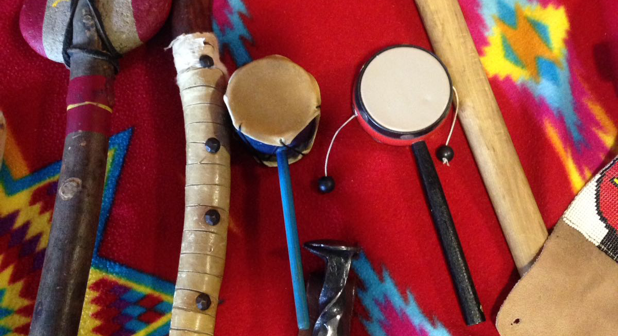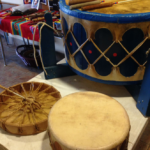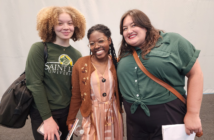- These are examples of tools used by the Native people. Each was built by hand from natural material available to them such as wood, rock, and precious metals.
- The jingle dress has many metal cones attached to it, making it quite a heavy piece of clothing. It is used in prayer and ritualistic dances and makes a characteristic sound as the wearer moves.
- The powwow drum is considered to be the “heartbeat” of the nation. The drums come in various shapes and sizes, each with their own distinct sound.
- Sharon Hall (to the left) and Kayden Williams (to the right) shared the culture of the Native American with the Saint Leo community through stories and artifacts on Nov. 2. Hall is dressed in the traditional Native style, while Williams is dressed in the fancy style.
- Fancy dresses are light and colorful because they used in fancy dancing which requires a lot of movement. The dancing also symbolizes the motion of a butterfly.
- Fans serve several purposes in the Native culture. For example, it can be used in dances or as a shield from the sun. They are usually made of feathers and animal hide.
By: Danielle Meikle
November marks the celebration of a culture that is often overlooked. The Office of Multicultural and International Services (MISO) put Native American heritage into the spotlight from Nov. 1 through Nov. 5 with several events that showcased different aspects of their culture.
“Storytelling and Native American Artifacts” took place on Nov. 2 and allowed students to view a number of relics that were used by Native Americans and learn the stories behind them.
On August 3, 1990, President George H. W. Bush declared the month of November “National American Indian Heritage Month.” This commemorative month provides a platform for Native American people in the United States of America to share their rich and diverse cultures, traditions, and histories with the rest of the population. It also serves as an opportunity to educate the public about the important contributions made by Native American people, and to raise awareness about the unique challenges that Native American people have faced both currently and historically.
There were many artifacts on display in the SCC Dining Hall lobby which caught the eye of students passing by, who then stopped to listen to the presentation. The stories were told by Sharon Hall, who is a descendant of the Muscogee Creek Tribe, and her little helper, Kayden Williams. Both were dressed in a Native American style, and they also had two other dresses on display.
“There are two types of dancing in the Native culture, fancy and traditional. She [Kayden] is dressed in fancy style, which involves a lot of movement and jumping; while I am dressed as traditional, which is much slower and sometimes we use fans and our shawls,” explained Hall.
Hall also explained that fancy dancing depicts the motion of a butterfly, and came about because of the younger girls in the tribe who wanted to dance in a more energetic manner. There was also a jingle dress on display, which is a dress used in prayer or ritual dancing that has metal cones on the end. It is said to weigh about ten pounds.
There were also powwow drums on display. A powwow is a gathering of Native people, and the drum is an integral and special part of their gathering. The powwow drum is played with two types of sticks, one of which is called the honor stick. The honor stick is shorter in length because it is used to play on the outside of the drum.
“It is called the heartbeat of the nation because it beats with the same rhythm of your heart, and every tribe has their own drum, so it is a unifying factor,” commented Hall.
Accompanying those larger items were some small handicrafts and clothing items. There were dolls made from pine and left over cloth. There were three types of neckwear to be seen; a shell chain which would be worn by a king or queen to signify royalty, chokers made from bone and black onyx that were worn by men going to war to protect their necks, and necklaces constructed with beans, acorns, dried corn, and clay stained with blueberries.
Small bags, called pocketbooks, could be viewed as well. Like the dolls, these were made from leftover material from sewing clothes. There was also a sash worn by men on their waist to signify their relationship status; if they were married, they wore it on the on the left side, while single men wore it on the right side.
“This tradition is still followed today, but instead married women wear a ring on the left hand,” added Hall.
One artifact that revealed a fascinating story was the sage. Sage is an herb with a very distinct smell and it is burned at special occasions such as weddings, funerals, and naming ceremonies. Interestingly, Native people are given four names throughout their lifetime: birth, child, adult, and crossover name, which is given at about age 60. Names are given by the elders of the tribe who take note of the personality of the person and use this to create a name. The birth name is the only exception; it is influenced by the time of year and weather during the birth of the person.
“Was it a time of moving or war in the tribe? Was it a rainy season? Or maybe during the winter or summer solstices,” explained Hall. She also added that her current name is “Wind Spirt” because of her personality, which is calm as a summer wind but, when troubled, she can become as dangerous as the winds of a hurricane.
The students who stopped by were quite intrigued by the presentation and willingly participated in it. Joey Williams, a sophomore accounting major, said, “I was truly fascinated by this [event]. It taught me something new about Native Americans and got rid of some of the mistaken ideas I had possessed in my head about them. I liked the fact that Kayden was doing most of the presenting because it is a good way for her to be more immersed in her culture. Plus, she was adorable to watch.”
Native American Heritage Week is an embodiment of the mission set out by the MISO office, as it gave students the opportunity to learn more about a different culture in an interactive way; one which they may not soon forget.
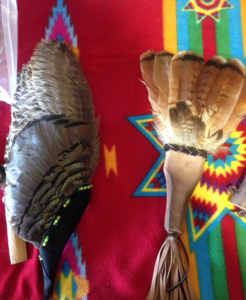
Fans serve several purposes in the Native culture. For example, it can be used in dances or as a shield from the sun. They are usually made of feathers and animal hide.
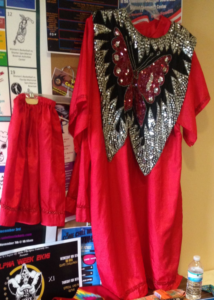
Fancy dresses are light and colorful because they used in fancy dancing which requires a lot of movement. The dancing also symbolizes the motion of a butterfly.
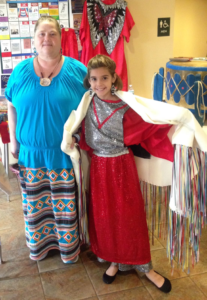
Sharon Hall (to the left) and Kayden Williams (to the right) shared the culture of the Native American with the Saint Leo community through stories and artifacts on Nov. 2. Hall is dressed in the traditional Native style, while Williams is dressed in the fancy style.
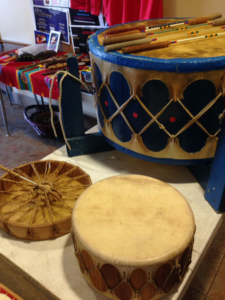
The powwow drum is considered to be the “heartbeat” of the nation. The drums come in various shapes and sizes, each with their own distinct sound.

The jingle dress has many metal cones attached to it, making it quite a heavy piece of clothing. It is used in prayer and ritualistic dances and makes a characteristic sound as the wearer moves.
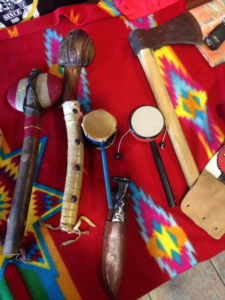
These are examples of tools used by the Native people. Each was built by hand from natural material available to them such as wood, rock, and precious metals.

